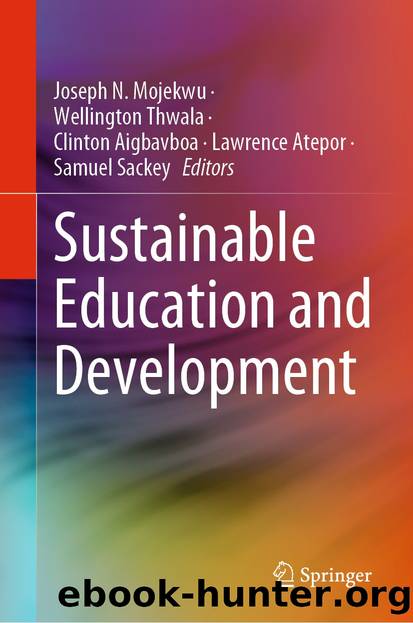Sustainable Education and Development by Unknown

Author:Unknown
Language: eng
Format: epub
ISBN: 9783030688363
Publisher: Springer International Publishing
3 Research Methodology
The research design for the study was cross sectional exploratory design which involved data collection at one point in time. The choice of this design based on the fact that it provided a very quick, efficient, accurate and economical means of accessing information about the population (Saunders 2011). This study was carried out in Singida, Morogoro and Mbeya regions, due to the fact that, Small Industries Development Organization (SIDO) Cluster Development Initiatives were based in those regions and had been in operation for a significant period of time (Diyamett and Komba 2008; Msuya 2011). The population was owners of clustered SMEs under CDIs in Singida, Morogoro and Mbeya regions. The sample size was 150 SMEs owners. These respondents were proportionately sampled randomly from each SME in clusters in the respective regions. Key informants were sampled purposefully as follows; 1 MIT official, 8 SIDO officials, 2 COSTECH officials, 7 SMEs cluster chair persons. These made a total of 18 key informants. Data were collected from both primary and secondary sources. Primary data were collected through survey method in which questionnaire tool was used to collect quantitative data to 150 SMEs owners.
Also interview guide as a tool for qualitative data collection was used to interview the key informants. Observation method through the use of observation guide was also used to collect primary data. Secondary data were collected in which various reports related to SMEs cluster were used. Quantitative data were sorted, coded and then entered into Statistical Packages for Social Sciences (SPSS) for analysis. For each CDIs support respondents scored 1 in each element of the support if they received and 0 if they did not receive. Then the scores were summed up into and index score of each support relative to the number of elements in each support. Then the mean of an index score of each support were compared by One way ANOVA across regions and clusters so as to examine the implementation status of CDIs. Qualitative data were mainly analyzed by thematic analysis in which the recurring themes and subthemes were typed and presented in line with the paper objective.
Download
This site does not store any files on its server. We only index and link to content provided by other sites. Please contact the content providers to delete copyright contents if any and email us, we'll remove relevant links or contents immediately.
| Automotive | Engineering |
| Transportation |
Whiskies Galore by Ian Buxton(40465)
Introduction to Aircraft Design (Cambridge Aerospace Series) by John P. Fielding(32344)
Small Unmanned Fixed-wing Aircraft Design by Andrew J. Keane Andras Sobester James P. Scanlan & András Sóbester & James P. Scanlan(32145)
Craft Beer for the Homebrewer by Michael Agnew(17450)
Turbulence by E. J. Noyes(7048)
The Complete Stick Figure Physics Tutorials by Allen Sarah(6644)
Kaplan MCAT General Chemistry Review by Kaplan(6060)
The Thirst by Nesbo Jo(5790)
Bad Blood by John Carreyrou(5776)
Learning SQL by Alan Beaulieu(5418)
Weapons of Math Destruction by Cathy O'Neil(5043)
Man-made Catastrophes and Risk Information Concealment by Dmitry Chernov & Didier Sornette(4744)
iGen by Jean M. Twenge(4703)
Digital Minimalism by Cal Newport;(4557)
Life 3.0: Being Human in the Age of Artificial Intelligence by Tegmark Max(4514)
Audition by Ryu Murakami(4103)
1,001 ASVAB Practice Questions For Dummies by Powers Rod(4044)
Electronic Devices & Circuits by Jacob Millman & Christos C. Halkias(4034)
Pale Blue Dot by Carl Sagan(4013)
